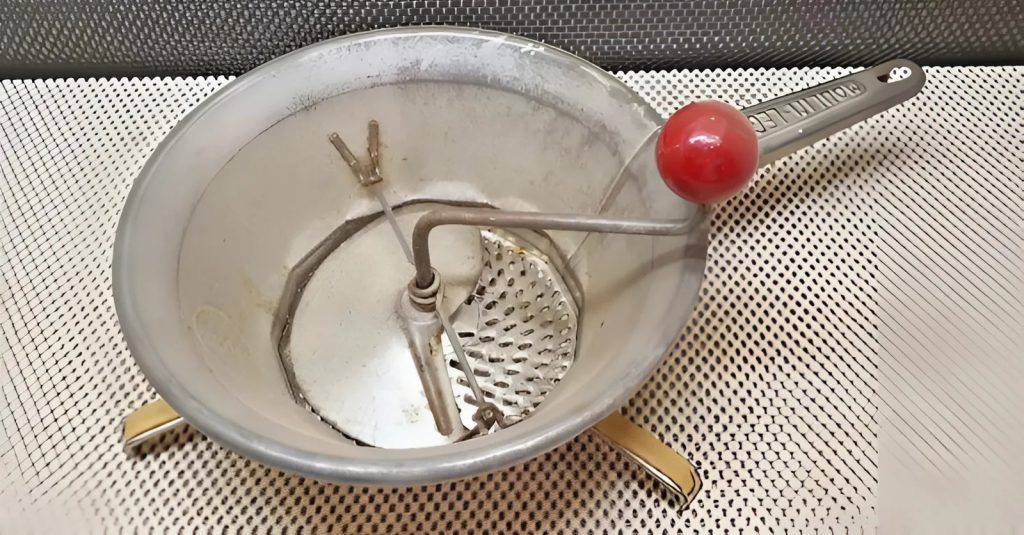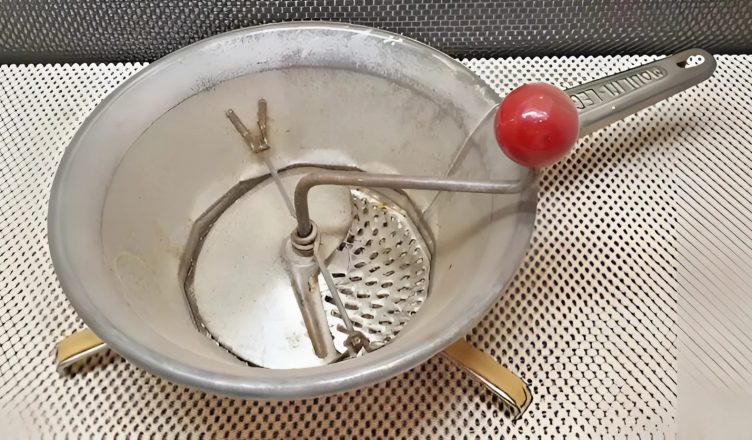My grandmother’s house in the French countryside feels like time stands still. Each room carries the weight of memory. The walls are lined with faded wallpaper, the air carries traces of lavender and aged wood, and every corner holds something curious, something old, something that feels like it was made to last.
But the kitchen — the kitchen is a world of its own. Copper pots hang from iron hooks. The table is thick, scratched, and stained from decades of meals, stories, and laughter. It was in that very kitchen, while helping her put away groceries, that I noticed an object I had never seen before.
Sitting quietly on the top shelf, half-hidden behind a ceramic teapot and a wooden spice box, was a dark, cast-iron tool. It looked like a ladle, but heavier, rougher. Its handle was long and slightly curved. At the bottom was a small perforated cup, darkened with age and use. I picked it up carefully. It was cold, solid, and mysterious.
— Grandma, what is this? — I asked.
She turned, gave a soft smile, and said, almost nostalgically:
— Ah, you found the brûle-parfum. We used to call it the kitchen incense burner.
I blinked. A kitchen incense burner? I’d never heard of such a thing. She motioned for me to sit. What followed was not just an explanation — it was a lesson in history, tradition, and how people once filled their homes with more than just light and furniture.
An Object that Carried Scent and Soul
The brûle-parfum, she explained, was once a common item in homes, especially in rural areas. At a time before air fresheners, scented candles, or plug-in diffusers, people relied on this simple object to give their homes a warm, welcoming scent.
Inside the perforated cup, they would place dried herbs, orange peel, cinnamon sticks, or drops of natural oil. Then, holding it over a gentle flame or placing it near the stove, the cast iron would heat, slowly releasing aromatic smoke throughout the room.

— In the winter, we used lavender and cloves, she recalled. In the summer, rosemary and mint from the garden. It wasn’t just about covering bad smells. It was about creating an atmosphere. A feeling of being home.
Listening to her, I realized this was more than just a tool. It was a ritual. A quiet act of care. A way to mark the shift from the outside world to the intimate warmth of home.
A Forgotten Ritual Worth Reviving
Today, our homes are filled with synthetic fragrances. We press a button and a chemical mist fills the air. We barely notice it. But my grandmother’s method required time, intention, and a connection to nature.
She told me how, before guests arrived, she would prepare a blend of dried orange peel and crushed cinnamon, light the burner, and let the scent gently infuse the space.
— Back then, we didn’t buy a scent. We made it.
Her words stayed with me.
I Had to Try It for Myself
That evening, she showed me how it worked. We lit a small flame on the stovetop, filled the cup with lavender and thyme, and gently warmed the iron. Within minutes, the kitchen smelled like the French countryside — earthy, soft, calming.
It wasn’t overpowering. It didn’t hit you in the face. It wrapped around you like a familiar blanket. I sat there, inhaling slowly, and I finally understood. Home isn’t just a place. It’s a sensation. And scent is part of that.
Now It Sits in My Own Kitchen
I took the burner home with me. It sits on a shelf in my own kitchen, in a modern apartment far from the fields of Provence. I don’t use it every day. But on quiet nights, when I want to remember or simply reconnect, I fill it with crushed herbs and light a flame.
And every time I do, I feel something shift. The air slows down. The space softens. The scent carries not just aroma, but memory — of my grandmother, of simplicity, of time well spent.
